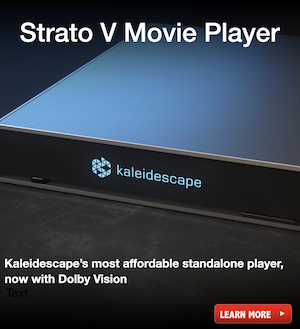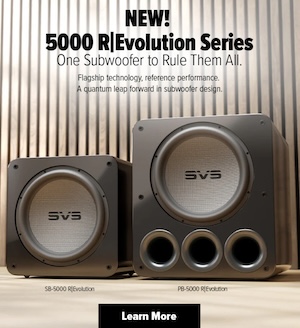Hi all, apologies for being late in the game here. I'm more "in-the-know" on the new HDMI 2.2 workings being done over the GPMI talks, but I will say this...pushing high bitrate in practical reaches does take time, both in cable implementation, and ecosystem growth (Source/Display/Repeaters) and at the moment, it seems as through while there is many adoption rumours circulating around GPMI, these are currently around TCL, Hisense amongst other Chinese-based manufactures (and yes, much of this will soon be thwarted by trade regardless). The aforementioned brands have definately broken through in North America in terms of Panel affordability, but the real question is Sources/Content (as is the case, always!). If GPMI can lock in a major CE brand (Sony, Samsung, LG etc.), I could see great progress here, but this is yet to be seen.
It's impossible to crystal-ball this....but there are many factors with varying timelines that must be ironed out regardless...here are the questions we first need answers to...
WE NEED TO THINK OUTSIDE THE CABLE...
1) US/China Trade: Without diving too deep (I'm Canadian and best not to get me started), this could Kibosh all the points I'm about to make. For example, does TCL/Hisense have the necessary momentum right now regarding high-volume consumer adoption in North America? Moreover, will this trade war stunt the progress of any new GPMI port as a standard?
2) Source Equipment: I have no hesitation in knowing the input/receiver port would be the first connections to exist. However, to the above point, will this cause other major CE brands to embrace this very new hardware implementation specifically on the source end? I simply can't see a world where a major CE brand would completely drop HDMI. HDMI + GPMI, I guess, but certainly not sans-HDMI as that would alienate their Source equipment completely from most panels. Also, didn't we spend decades replacing multiple connections to optical players, only to start building up more?
3) Content: Are true filmmakers ever genuinely consulted on what they actually need? I often wonder whether, at the highest levels, there's any meaningful engagement with creators from a user-experience perspective. Take 192Gbps/GPMI, for example, could this be a creative enabler, particularly in tandem with emerging VR workflows? Each market segment seems to be forging its own path, adapting connectivity to suit its specific application and it's own electronics...cables are just along for the ride after all. But eventually, multiple industries will converge on a single, unified method of connecting AV equipment, shouldn't the content creators be the ones pushing for what that standard looks like? Consider the early days of the optical disc. The laser type and size more or less dictated how much data could fit, thereby defining the ceiling for resolution, bit-depth, chroma subsampling, and frame rate, even if those were all discussed in the spec development. I once heard an industry expert first-hand involved in the original Blu-ray spec explain that these technical limitations shaped content delivery far more than creative vision. But today, digital storage is virtually limitless (yes, cost is still a factor). So here’s the question: will that shift finally remove the legacy constraints from the next generation of AV playback systems? Or are we still building to limitations that no longer need to exist?
4) Optical vs. Storage (vs. Streaming): I should preface that these are my own opinions on the wonderful world of AV connectivity. Yes, our THX Interconnect cables, designed with Pixelgen, are in Kscape boxes. Please keep in mind that we're in those boxes due to the mutual respect for delivering the best possible experience to the user, from all perspectives. 4K-movie storage pioneers like K-scape, are emphasizing the demand for more bits when it comes to maximizing the home theatre experience, and there is real advantage here that make a noticeable difference in content quality today. I've personally experienced 4K discs up against uncompressed 4K movie/storage (KScape), and the latter is definitely the way we will go, in my opinion. Kscape delivers very real visual advantages to the eye, and the increased demand for more bits is certain to come. Optical UHD-BR disc sales are actually beginning to outperform BR (but never DVD! :-) Does UHD-BR become the VINYL of movies?... always there to literally blow the dust off? Or are we moving towards a world where we can truly accept always having the best, and quickly, and have it all be OWNED, just not held? (CD's vs. Music streaming anyone?). From a source/content perspective, accessible (and owned) storable movies in the absolute highest quality, will (eventually) win in my opinion. Lastly, streaming will thrive for some time, until the gap between streaming and Optical-or-Storage becomes increasingly more noticeable to the common eye...and that day will come eventually.
5) History: DisplayPort has technically been ahead of the curve for a long while in terms of cable bandwidth capabilities, but there's a reason that dual DP/HDMI input adoption only exists in stationary PC-monitors. There's a good reason you don't see HDMI and DP inputs together in harmony. The end customer simply wants the highest quality input without needing to make a choice. Translating the need for GPMI over HDMI for the masses will be a challenge. As a side, you best prepare for world-wide eye rolling at our family members hearing about "GP"MI now.
6) Practical Reaches: In 2025, we're still talking devoted-Source equipment, and obviously devoted-Display equipment, therefore, a distance to communicate, thus devoted cables (Todd, I cannot talk wireless for a single second, as I'd be scared to walk through a point-to-point wireless connection at these bitrates). In cabling, as we know, a major factor is reach, practicality and fitness-to-application (i.e. useable real-world cable reaches).
If we strictly compare passive cables, here are the limitations...
- 4K HDMI 2.0 (18Gbps) would allow us ~8-10m (albeit much thicker than we'd like) and the optical options matured to obtain up to 15-20m with relative ease.
- 4K/8K HDMI 2.1 (40/48Gbps) would allow up to 5m MAX (yes, 5-8m is possible, but absolutely garden-hoses). Therefore, still very reasonable reaches for most connections.
- 8K/16K HDMI 2.2 (96Gbps). At this moment in time, hypothetically speaking, if the 4 highspeed channels, previously maxing out the reuse of these high-speed channels at 12Gbps is set to switch to 24Gbps (12G X 4 = 48G, 24G X 4 = 96G), then the theoretical ceiling of passive copper cabling would be ~2-2.5m in length MAX. This is definitely a concern, and I'm interested to see how the types of panels (i.e. very large panels) that would require 16K content advantages would be able to use 2m, practically speaking in application.
- GPMI (192Gbps): If we are talking TypeB 192Gbps, my best guess would be more wire pairs of devoted high-speed signaling (so, aggregate bandwidth of 8 pairs X 24Gbps = 192Gbps). OR, will GPMI adopt optical prowess for all GPMI cabling, even down to 3ft? There is an argument to be made here. Almost like audio TOSLINK adoption, however, this would be very unlikely IMO as the gap between a single audio fiber and multiple fibers (for A + V)... and either embedded or externally-embedded optical modules is quite big. Wouldn't be cheap either.
My personal belief, is that the champion connectivity standard will be the one that finds the balance between application reach (say 5m), slimmer and more user-friendly cabling, and the highest bandwidth/compatibility. In the end, I reject the notion that anyone has it all figured out as most of the conversation occurs OUTSIDE of cable talk. The landscape is far too complex, with too many moving parts and perspectives (and politics!) to predict how it will all unfold. But one thing remains clear to me: the answer almost always begins with the artist, the filmmaker, and from there, it becomes a matter of how the hardware, and its very real limitations, can faithfully carry that creative vision to the consumer.
Jack | PIXELGEN, Founder & CEO









